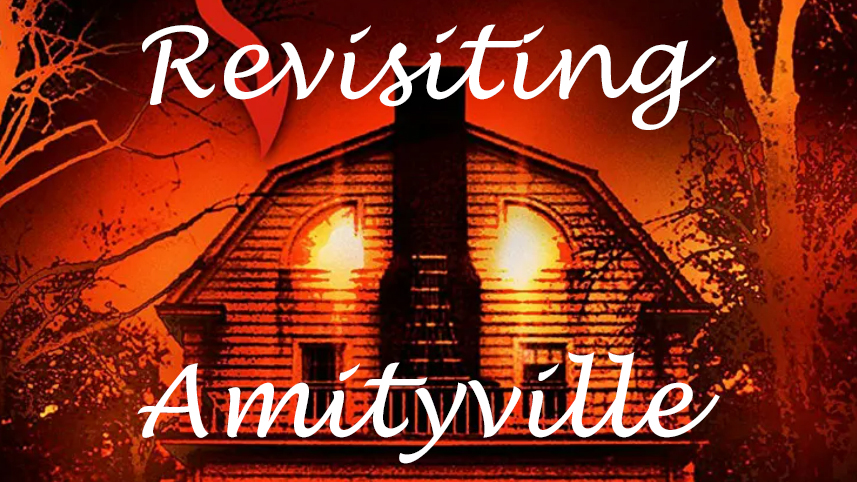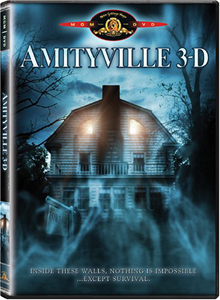“Amityville 3-D” (1983) hit theaters at the intersection of a couple of trends: one, sequels as ways to cash in on a horror franchise, and two, the popularity of 3-D theatrical releases. It joins “Friday the 13th Part III” and “Jaws 3” as a notable third-in-a-series horror film from the time to use the technology.
It’s about even with the “Friday” entry, and better than the “Jaws” entry. It has cachet off the bat, with Richard Fleischer (“Soylent Green”) directing and Tony Roberts (the best friend in Woody Allen movies in the Seventies) starring.
Although some have contended that the continuity is messed up, I think it flows well from the DeFeo murders (in the first film’s prolog), the Lutz hauntings (“The Amityville Horror”) and the Montelli killings (“Amityville II: The Possession”). It’s true that only the DeFeo killings are mentioned in the dialog (likely due to legal issues with the Lutzes) but that’s a minor quibble.

“Amityville 3-D” (1983)
Director: Richard Fleischer
Writer: David Ambrose
Stars: Tony Roberts, Tess Harper, Robert Joy
On Tuesdays this summer, RFMC is looking back at selected films in the “Amityville” series.
Leaving the ‘true stories’ behind
Since the second film’s Montelli story is patterned after the DeFeo events, “3-D” marks the first time we leave the “true stories” behind. (Roberts’ John Baxter is inspired by a real Amityville hoax-buster, but the story beyond that is made up). As we segue smoothly into fictional territory, the pleasures come from simply being in the Amityville house again, similar to returning to the Bates Motel in the “Psycho” saga.
It’s fun to take a tour with new owner John, his daughter Susan (Lori Laughlin) and Susan’s friend Lisa (Meg Ryan). I like how the house looks the same in every film, particularly that attic bedroom with the eye-windows. The basement does have new quirks each time, granted. This time we have a Hell Well rather than a Red Room.
As we move into the unabashedly fictional “Amityvilles,” screenwriter David Ambrose appropriately has something to say about the nature of reality (or realities). Paranormal scientist Dr. Elliot West (Robert Joy) notes that reality is the only word in the English language that should always have quotes around it.
“3-D” starts by turning a cliched sequence into a clever one: We’re not seeing a successful séance. Rather, John – a star reporter for Reveal magazine — and colleague Melanie (Candy Clark) are debunking the false medium.
Anyone who wishes characters in haunted-house films would arm themselves with recording devices will love “3-D.” West’s people are more prepared for the ghosts and demons than the Colonial Marines are for the xenomorphs in “Aliens.” The grand finale, wherein the house is filled with scientists and A/V equipment, is almost a parody of “Poltergeist” from the year before.

Visuals are in 3-D; the narrative is in 2-D
But there’s a problem with “3-D”: The events too often come off as 2-D. “3-D” has no (intentional) sense of humor nor sense of dread. John loses two loved ones over the course of the story. (One goes in an impressive bit of gore horror, capped by a use of 3-D that must’ve been fun in the theater.) But events quickly move forward to the investigation of the house.
The stakes are both muted and unclear. If audiences were comparing it to “Poltergeist,” with the clear stakes of a little girl trapped in a ghost dimension, they’d find “3-D” muddled. Roberts has enough gravity to hold our attention, but his skeptic-to-believer arc is wholly expected, and it’s unclear what exactly John hopes will happen in the final act.
As noted, Fleischer wisely revels in the house early on, and he competently directs the scare shots, although the practical effects are a big step down from “Possession.” John’s and West’s intellectual approach to this problem promises more than it delivers. Ambrose doesn’t have a whole lot to say about the demon realm other than the fact that it exists – which we know from the first two films.
Practical effects and pyrotechnics provide a grand finale – like how the Death Star II battle capped off another trilogy this same year. And “3-D” deserves credit for tackling a haunted house with absolutely every bit of technology you can throw at it. The cast can’t match that of the first two films, but the main characters behave smartly.
It’s easy to watch (105 minutes isn’t a tough ask), but ultimately flat and forgettable. I imagine it’ll look like a gem once I delve further into the sequels, but “Amityville 3-D” is the weakest of the original “Amityville” trilogy.

